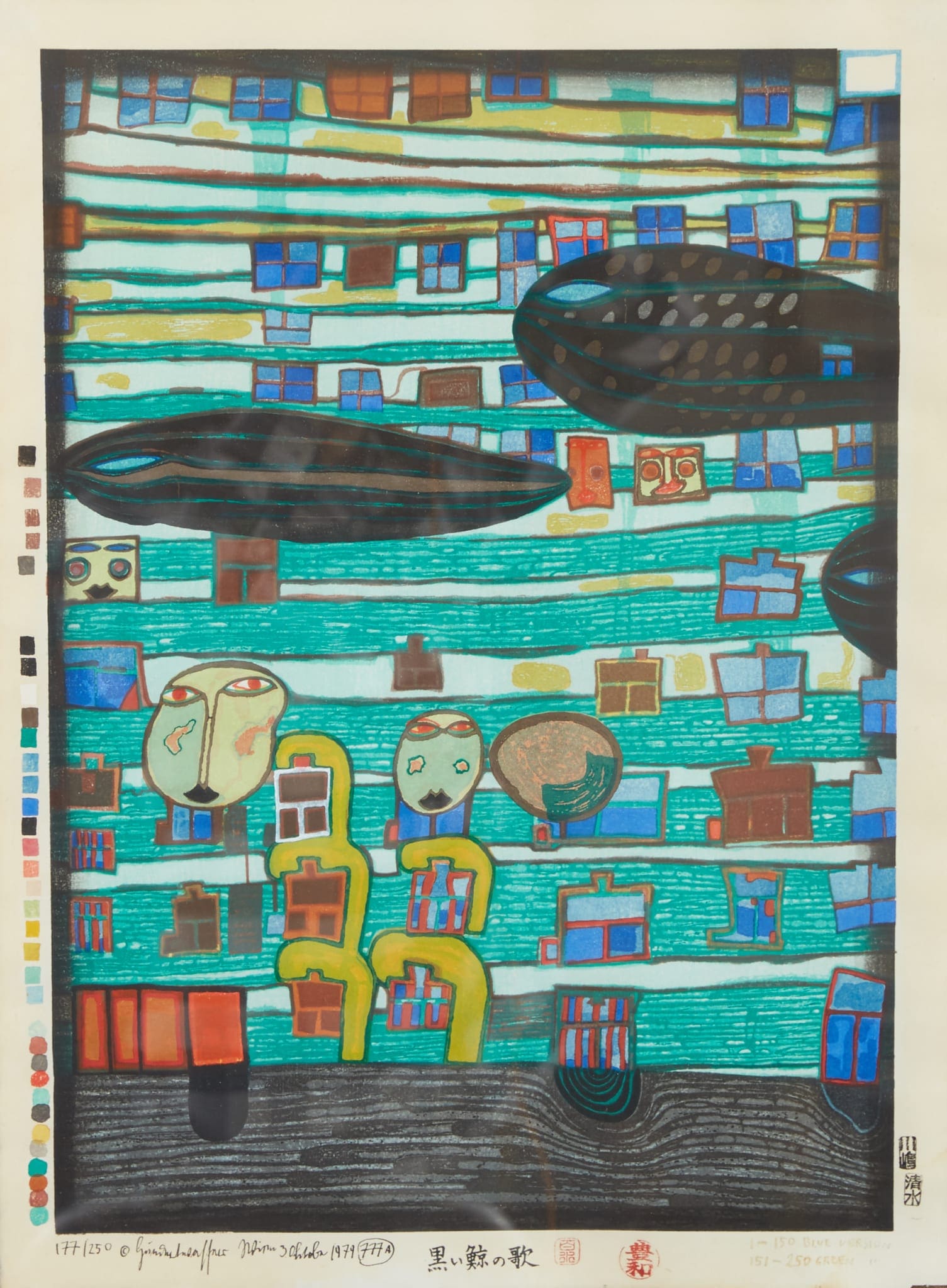
Friedensreich Hundertwasser (1928-2000). Woodblock print on Japan titled “Song of the Whales.” Hand signed and numbered 177/250 along the lower right. This is one of 150 impressions printed in green; the remainder was printed in blue.
Literature: Koschatzky 77
Biography:
ìParadise is there, but we destroy it.
I want to show how basically simple it is to have paradise on earth.?
Artist, environmentalist, and free thinker Friedensreich Hundertwasser set out to change the world through his works–to create a paradise on earth. Both through and alongside his art, he fought for the environment and for peace, prolifically creating, protesting, and publishing.
Born Friedrich Stowasser in Vienna in 1928, he was raised under unusual circumstances which shaped his later worldview. His father died when he was very young, and he was raised by his mother. His mother’s family was Jewish, and while he and his mother were safe, since his father was a Christian, almost his entire extended family was killed by the Nazis, a tragic event which had a profound effect on young Friedrich’s worldview. He had little formal art education, during his childhood, but created art constantly throughout, often drawing from nature.
He entered the Vienna Art Academy after graduating from secondary school, but left after only three months. At the age of 21, he changed his name to Friedensreich Hundertwasser, meaning “Peace-Kingdom Hundred-Water.” During his early 20s, he began traveling extensively, leading an almost nomadic existence that he would continue throughout much of his life. Despite his relative lack of formal training, he worked in the workshops of many artists during this period, and soon gained artistic success, joining the Art Club of Vienna in 1951 and staging an exhibition through them the following year. This was followed by many more exhibitions and growing international recognition for his art.
During his long and productive career, Hundertwasser worked in a wide variety of media. He did a large number of paintings and prints, and was the first European artists to work with Japanese artists to create woodblock prints in their traditional method. He additionally worked a great deal with tapestries and applied art. He made several forays into architecture, and his buildings demonstrate the dislike of straight lines he fostered in his more traditional art. He also designed stamps, created films, and even experimented with designing ways to be more environmentally friendly, such as humus toilets and water filtration systems.
It is impossible to separate Hundertwasser’s art, in all its many forms, from his activism and philosophies. Throughout his career, he published many essays and manifestos, through which he explored new philosophies for understanding the world and sought to make the world a better place. His primary concerns were for environmental conservation and peace in the world. He frequently published and lectured on these topics, as well as creating art to display his ideas and goals. Along with winning acclaim for his art, Hundertwasserís activism was recognized with many awards.
Eventually, Hundertwasser bought land in New Zealand which became his home base and a place where he felt at one with nature. This was important for him, as he finally had a space where he was able to live out his philosophies and interact with the earth as he saw fit. He continued to travel, however, creating art, teaching, and writing until his death at sea in 2000, following which he was buried on his land in New Zealand.
This print, “Song of the Whales,” shows how Hundertwasser’s worldview makes subtle appearances in his art, showing humans, architecture and nature integrated in a seamless way. The whales float above human faces, which seem also to float in their environment. The curves and texture of the print mimic the wood from which it was printed, cleverly tying a human effort to its natural source. This piece is an excellent example of Hundertwasserís work, demonstrating his skill and all the elements for which he is best known.
Sight; height: 22 1/4 in x width: 16 1/4 in.
Framed; height: 29 in x width: 22 1/2 in.
$3,500